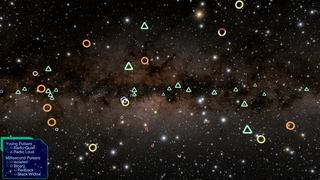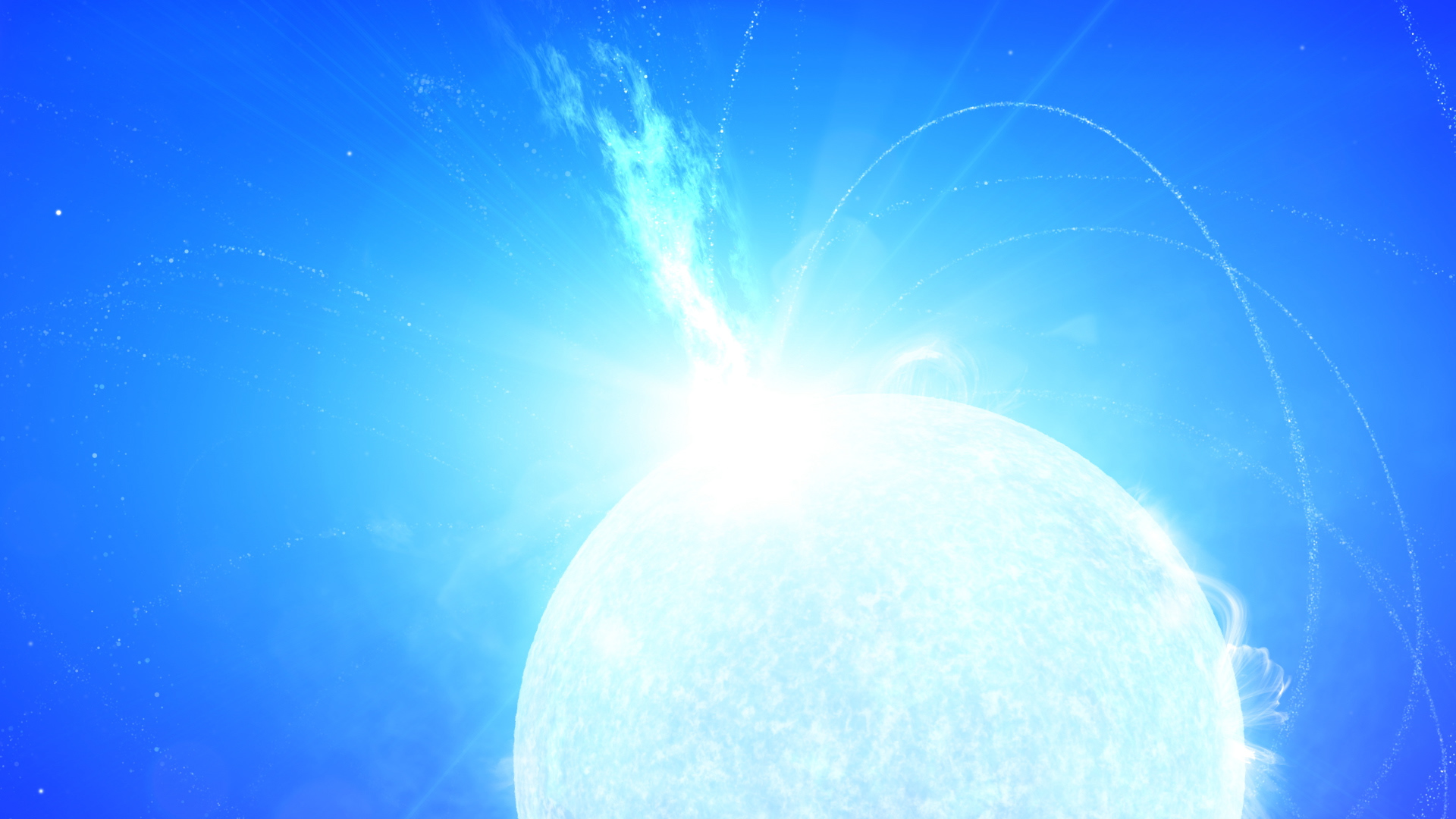NASA Missions Unveil Magnetar Eruptions in Nearby Galaxies
On April 15, 2020, a wave of X-rays and gamma rays lasting only a fraction of a second triggered detectors on NASA and European spacecraft. The event was a giant flare from a magnetar, a type of city-sized stellar remnant that boasts the strongest magnetic fields known. Watch to learn more.
Credit: NASA’s Goddard Space Flight Center
Music: "Collision Course-Alternative Version" from Universal Production Music
Watch this video on the NASA Goddard YouTube channel.
Complete transcript available.
On April 15, 2020, a brief burst of high-energy light swept through the solar system, triggering instruments on several NASA and European missions. Now, multiple international science teams conclude that the blast came from a supermagnetized stellar remnant known as a magnetar located in a neighboring galaxy.
This finding confirms long-held suspicions that some gamma-ray bursts (GRBs) – cosmic eruptions detected somewhere in the sky almost daily – are in fact powerful flares from magnetars relatively close to home.
The April 15 event, cataloged as GRB 200415A, is a game changer because, for the first time, the burst's estimated location is almost entirely within the disk of one galaxy – NGC 253, located 11.4 million light-years away. This is the most precise position yet established for a giant flare located well beyond our galaxy.
GRBs, the most powerful explosions in the cosmos, can be detected across billions of light-years. Those lasting less than about two seconds, called short GRBs, occur when a pair of orbiting neutron stars both the crushed remnants of exploded stars spiral into each other and merge.
Magnetars are neutron stars with the strongest-known magnetic fields, with up to a thousand times the intensity of typical neutron stars and up to 10 trillion times the strength of a refrigerator magnet. Rarely, magnetars produce enormous eruptions called giant flares that produce gamma rays, the highest-energy form of light.
Shortly before 4:42 a.m. EDT on April 15, a powerful burst of X-rays and gamma rays triggered, in turn, instruments on NASA's Mars Odyssey mission, Wind satellite, and Fermi Gamma-ray Space Telescope. A ground-based analysis of data from NASA's Neil Gehrels Swift Observatory show that it also detected the event.
The pulse of radiation lasted just 140 milliseconds, as fast as a blink of the eye or a finger snap. Fermi's Large Area Telescope (LAT) also detected high-energy gamma rays up to several minutes after this pulse, a surprising finding.
Analysis of Fermi and Swift data indicate that the outburst launched a blob of electrons and positrons moving at about 99% the speed of light. The blob expanded as it traveled, following closely behind the light emitted by the giant flare.
After a few days, scientists say, they reached the boundary separating the magnetar's region of influence from interstellar space. The light passed through, followed many seconds later by the greatly expanded cloud. This material induced shock waves in gas piled up at the boundary, and the interaction produced the highest-energy emission detected by the LAT.
Astronomers explain the observations of GRB 200415A with the sequence of events illustrated here. A magnetar is a city-sized ball containing more mass than the Sun and boasting the strongest magnetic fields known. A sudden reconfiguration of this field, possibly caused by a starquake, produced a quick, powerful pulse of X-rays and gamma rays. The event also ejected a blob of matter, which followed the pulse and moved slightly slower, at about 99% the speed of light. After a few days, they both reached the boundary, called a bow shock, where a steady outflow from the magnetar causes a pile-up of interstellar gas. Light from the flare passed through, followed many seconds later by the fast-moving cloud of ejected particles. They interacted with gas at the bow shock, creating shock waves that accelerated particles and produced high-energy gamma rays. This accounts for the delay in the arrival of the most energetic gamma rays detected by NASA's Fermi mission.
Credit: NASA’s Goddard Space Flight Center/Chris Smith (USRA/GESTAR)
Music: "Collision Course" from Universal Production Music
Watch this video on the NASA.gov Video YouTube channel.
Complete transcript available.
Scientists think the giant flare cataloged as GRB 200415A began with an abrupt rearrangement of a magnetar's magnetic field, possibly caused by a starquake. This change produced a quick, powerful pulse of X-rays and gamma rays (magenta). The event also ejected a blob of electrons and positrons traveling at about 99% the speed of light.
Credit: NASA’s Goddard Space Flight Center/Chris Smith (USRA/GESTAR)

A GIF version of the above.
Credit: NASA’s Goddard Space Flight Center/Chris Smith (USRA/GESTAR)
The initial pulse of X-rays and gamma rays (magenta) traveled away from the magnetar, followed closely by the expanding cloud of particles, which moved only slightly slower.
Credit: NASA’s Goddard Space Flight Center/Chris Smith (USRA/GESTAR)
After a few days, both the flare's light and the cloud of ejected matter approached the boundary, called a bow shock, where a steady outflow from the magnetar causes a pile-up of interstellar gas. The quick pulse of light from the flare passed through, followed many seconds later by the fast-moving cloud, which had grown larger and more diffuse. The cloud interacted with gas at the bow shock, creating shock waves that accelerated particles and produced the highest-energy gamma rays.
Credit: NASA’s Goddard Space Flight Center/Chris Smith (USRA/GESTAR)
Unlabeled version of the sequence above.
Credit: NASA’s Goddard Space Flight Center/Chris Smith (USRA/GESTAR)
This schematic view illustrates the sequence of events that explains the observations of GRB 200415A. A magnetar (left) is a city-sized ball containing more mass than the Sun that boasts the strongest magnetic fields known. A sudden reconfiguration of this field produced a quick, powerful pulse of X-rays and gamma rays (magenta). The event also ejected a blob of electrons and positrons traveling at about 99% the speed of light. After a few days, they both reached the boundary, called a bow shock, where the magnetar's steady outflow of particles causes interstellar gas to pile up. Light from the flare passed through, followed many seconds later by the expanded cloud of particles. The fast-moving cloud interacted with gas at the bow shock, creating shock waves that accelerated particles and produce gamma rays. This accounts for the delay in the arrival of the highest-energy light detected by NASA's Fermi spacecraft.
Credit: NASA's Goddard Space Flight Center
This sequence shows the estimated locations of bursts now recognized as magnetar giant flares in galaxies far beyond our own. Detections by different spacecraft define bands of possible locations. A box (red outline) defined by the intersection of these bands marks the flare's best position. Portions of the localizations for flares from M81 (2005), M31 and M83 (both in 2007) include these galaxies. In contrast, the localization box for the 2020 flare in NGC 253 lies almost entirely within the galaxy's disk. This is the most precise position yet established for a magnetar located well beyond our galaxy.
Credit: NASA's Goddard Space Flight Center, DSS, SDSS, and Adam Block/Mount Lemmon SkyCenter/University of Arizona

Detections of GRB 200415A by NASA's Fermi, Wind, Mars Odyssey, and Swift missions provide bands of possible locations. These bands overlap in the central region of the Sculptor galaxy.
Credit: NASA's Goddard Space Flight Center and Adam Block/Mount Lemmon SkyCenter/University of Arizona
Giant flares from magnetars in or near the Milky Way evolve in a distinct way, with a quick rise to peak brightness followed by a rapidly fluctuating tail of emission. This spiky tail results from the magnetar's spin bringing the flare's hot spot in and out of view, and it is conclusive evidence of a giant flare. Seen from millions of light-years away, though, this tail emission is too dim to detect with today’s instruments, as shown in this illustration. Because this signature is missing, giant flares in our galactic neighborhood can masquerade as much more distant and powerful merger-type GRBs.
Credit: NASA’s Goddard Space Flight Center

A GIF version of the above.
Credit: NASA's Goddard Space Flight Center

NGC 253 is a bright spiral galaxy located about 11.4 million light-years away in the constellation Sculptor.
Credit: Copyright Dietmar Hager and Eric Benson, used with premission

NGC 253, also known as the Sculptor galaxy or the Silver Dollar galaxy, is a bright spiral located about 11.4 million light-years away in the constellation Sculptor.
Credit: Copyright Adam Block/Mount Lemmon SkyCenter/University of Arizona, used with permission

This illustration shows magnetar giant flares (magenta circles) associated with galaxies well beyond our own. The 2020 flare in NGC 253 is the first one to be located so precisely that the errors in its position all lie within the galaxy's disk. Astronomers now think a few percent of short GRBs really are relatively nearby magnetar giant flares, as opposed to much more distant and powerful merger events.
Credit: NASA's Goddard Space Flight Center

This illustration shows the three nearest magnetar giant flares (magenta circles) known. The first one erupted in 1979 in the Large Magellanic Cloud, a satellite of our Milky Way galaxy located about 163,000 light-years away. The others erupted in 1998 and 2004 within our galaxy. The 2004 event produced brief, measurable changes to Earth's ionosphere despite occurring about 28,000 light-years away.
Credit: NASA's Goddard Space Flight Center
For More Information
Credits
Please give credit for this item to:
NASA's Goddard Space Flight Center. However, individual items should be credited as indicated above.
-
Producer
- Scott Wiessinger (USRA)
-
Science writer
- Francis Reddy (University of Maryland College Park)
-
Animators
- Chris Smith (USRA)
- Scott Wiessinger (USRA)
-
Narrator
- Scott Wiessinger (USRA)
-
Editor
- Scott Wiessinger (USRA)
Release date
This page was originally published on Wednesday, January 13, 2021.
This page was last updated on Wednesday, May 3, 2023 at 1:44 PM EDT.
Missions
This page is related to the following missions:Series
This page can be found in the following series:Related papers
https://www.nature.com/articles/s41586-020-03076-9
https://www.nature.com/articles/s41586-020-03077-8
https://www.nature.com/s41550-020-01287-8
https://www.nature.com/articles/s41586-020-03076-9
https://www.nature.com/articles/s41586-020-03077-8
https://www.nature.com/s41550-020-01287-8


